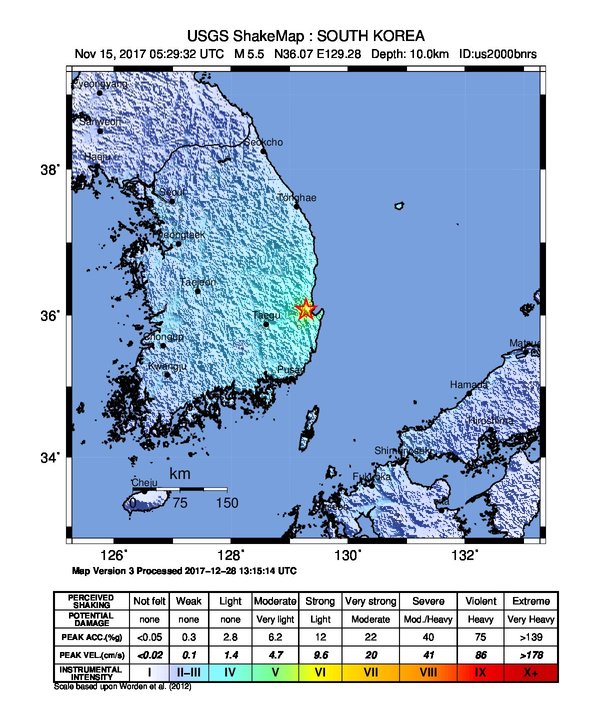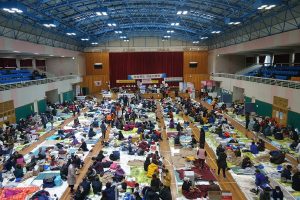Pohang, South Korea - 2017
a day that shook a nation and its people -
U. (2017, December 28). USGS ShakeMap: South Korea [Digital image]. Retrieved October 22, 2020, from https://commons.wikimedia.org/wiki/Category:2017_Pohang_Earthquake#/media/File:2017_Pohang_earthquake_intensity_map.jpg
When talking about earthquakes we rarely ever think about countries such as South Korea. To be fair South Korea also rarely have earthquakes. in the past 365 days, only 3 has accord. However, power is not to be underestimated. This year alone South Korea has seen earthquakes with magnitudes of 6.3 that's very significant. But today we're going to talk about the 2017 Pohang earthquake.

E. (2017, 15, November). [Wall crumbles onto car]. Retrieved October 22, 2020, from https://www.scmp.com/news/asia/east-asia/article/2120157/rare-quake-south-korea-left-1500-homeless-dozens-injured-and
November 15, 2017, it was just like any other day in the southeast city of Pohang. A city of about 516,000 residents. Until the 5.5 magnitude earthquake struck. It struck the city with enough force to crumble walls, crack roads, and collapse old buildings. causing over 90 people to have injuries and causing over $52 million in economic damages. Not only were man-made structures damaged but so was the land. Fissures were open due to this high magnitude earthquake. At the time it was the 2nd strongest earthquake South Korea has experience after starting to monitor them in 1978. The state-run Korea Meteorological Administration said the epicenter was inside Pohang while the US Geological Survey said it was centered about 9.3 kilometers northwest of the port city. This conflicting information is actually very important to this story. The people of Pohang actually sued the state due to this earthquake being quote "mad made". People were lead to believe the earthquake was caused in part due to the influence of the local industrial activities the state was taking in part in. In the area, the government was using high-pressure hydraulic injection for the past 2 years for a geothermal power generator. Which is known to raise the possibility of an earthquake. The location that was chosen is a very enhanced geothermal system site, so it's very highly that the earthquake was in part anthropogenic in nature. Without a doubt this highly impactful event could have been mitigated by the government it chose not to set up a geothermal plant, instead, it did. But the fact doesn't change how they reacted afterward. South Korea is a very efficient country when it comes to helping its people in a crisis. Due to building codes and public knowledge people were at a lower vulnerability than say Haiti.
[Digital image]. (n.d.). Retrieved October 22, 2020, from https://www.gettyimages.com/photos/south-korea-posco-steel-plant?mediatype=photography&phrase=south%20korea%20posco%20steel%20plant&sort=mostpopular

In the end, this earthquake could have been very dangerous if the country wasn't as modern as it is today. I still believe the country needs to take more steps into protecting its people's best interest and also its economic ones. Yet I feel as if they knew what would happen. The science indicates that making geothermal generators on seismically active areas will indirectly cause earthquakes. The government found that out the hard way.
Citation
Grigoli, F., Cesca, S., Rinaldi, A., Manconi, A., López-Comino, J., Clinton, J., . . . Wiemer, S. (2018, June 01). The November 2017 Mw 5.5 Pohang earthquake: A possible case of induced seismicity in South Korea. Retrieved October 23, 2020, from https://science.sciencemag.org/content/360/6392/1003.full
Paul VoosenApr. 26, 2., Peter Behr, E., Lindzi Wessel, R., Pratik PawarOct. 20, 2., Scott Waldman, E., Rebekah Tuchscherer, R., . . . Rasha AridiSep. 23, 2. (2018, April 30). Second-largest earthquake in modern South Korean history tied to geothermal plant. Retrieved October 23, 2020, from https://www.sciencemag.org/news/2018/04/second-largest-earthquake-modern-south-korean-history-tied-geothermal-plant
Recent Earthquakes Near South Korea. (n.d.). Retrieved October 23, 2020, from https://earthquaketrack.com/p/south-korea/recent
Yesterday's earthquake in South Korea was the second-strongest the country has ever been hit by. (2017, November 16). Retrieved October 23, 2020, from https://www.independent.co.uk/news/world/asia/south-korea-earthquake-latest-pohang-quake-second-strongest-record-5-4-magnitude-a8057946.html
Staff, S. (2019, March 20). Geothermal plant 'triggered earthquake' in S. Korea. Retrieved October 23, 2020, from https://phys.org/news/2019-03-geothermal-triggered-earthquake-korea.html


















